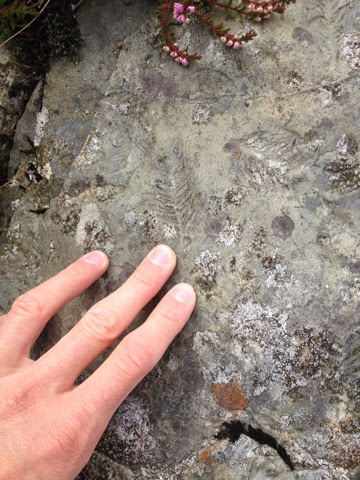RobinGriffiths
Well-known member
I had a little walk around Nantlle Lake today, hoping to 'take in' the shaft marked on the OS map at SH 5272 5279. In fact it was an adit in a very ferruginous ridge of rock. I don't doubt there actually is a shaft a bit higher up on the hillside, which I'm reserving for a wander into the valley above at some point.
But the interesting thing, when looking at the Nantlle Valley mines on a BGS map- Benallt, Simdde Dylluan, Drws y Coed (including other lesser trials from the Wilkinson Gazeteer), they all seem to be aligned with the outcrop of Carnedd y Filiast Grit. Sometimes in the underlying Marchlyn Formation, sometimes in the overlying Nant Ffrancon Subgroup, which no doubt would hit the Marchlyn Formation at depth. So my hypothesis is that in the Nantlle Valley, the Carnedd y Filiast Grit (coarse sandstone and conglomerate) acted as some sort of cap, with mineralisation forming below it in the Marchlyn Formation (mudstones and siltstones). The CYF Grit is quite a robust rock, forming escaprments in the vicinity.
Looking outside the Nantlle area there is a similar pattern in other areas where the CYF Grit outcrops. Llanberis Mine, Ceunant Mine (in the Ogwen Valley), Blaen y Pennant, Gilfach and Cwm Cipwrth in the Pennant Valley.
Ironically, I don't think my 'mine of the day' fits into this pattern. I suspect it's an analogue of the pisolitic iron mines in the Nant Francon Subgroup at Betws Garmon. (Ystrad and Silurian Mines)
But the interesting thing, when looking at the Nantlle Valley mines on a BGS map- Benallt, Simdde Dylluan, Drws y Coed (including other lesser trials from the Wilkinson Gazeteer), they all seem to be aligned with the outcrop of Carnedd y Filiast Grit. Sometimes in the underlying Marchlyn Formation, sometimes in the overlying Nant Ffrancon Subgroup, which no doubt would hit the Marchlyn Formation at depth. So my hypothesis is that in the Nantlle Valley, the Carnedd y Filiast Grit (coarse sandstone and conglomerate) acted as some sort of cap, with mineralisation forming below it in the Marchlyn Formation (mudstones and siltstones). The CYF Grit is quite a robust rock, forming escaprments in the vicinity.
Looking outside the Nantlle area there is a similar pattern in other areas where the CYF Grit outcrops. Llanberis Mine, Ceunant Mine (in the Ogwen Valley), Blaen y Pennant, Gilfach and Cwm Cipwrth in the Pennant Valley.
Ironically, I don't think my 'mine of the day' fits into this pattern. I suspect it's an analogue of the pisolitic iron mines in the Nant Francon Subgroup at Betws Garmon. (Ystrad and Silurian Mines)




